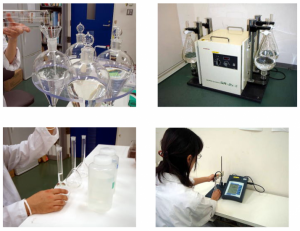1. 変圧器の過熱発生箇所
変圧器の過熱は主に以下の箇所で発生します。
①巻線(コイル)内部
変圧器のコイル(一次巻線および二次巻線)に電流が流れると発熱します。特に過負荷や異常電流が発生すると、巻線内部の温度が急上昇し、絶縁劣化や焼損に至ることがあります。
②絶縁材料(油や樹脂など)
油入変圧器では、巻線や鉄心の熱が油に伝わり、内部の絶縁油が過熱することがあります。モールド変圧器では、樹脂絶縁体のひび割れや欠けも過熱の兆候となることがあります。
③端子および接続部
端子やタップ切換器の接触不良、あるいは締結具の緩みは、接触抵抗の増大や局所的な発熱(ホットスポット)を引き起こす可能性があります。変色や端子部の焼損につながる可能性があります。
④コア(鉄心)
コア自体も渦電流などの影響で発熱することがあります。通常、巻線や端子ほど温度上昇は大きくありませんが、異常が発生すると過熱する可能性があります。
2.過熱の原因と対策
①過負荷や異常電流が主な原因です。変圧器に定格を超える負荷がかかると、巻線や絶縁体の温度が急激に上昇することがあります。
②接触不良や締結具の緩みも、局所的な過熱につながります。
③冷却不足(油の劣化やファンの故障など)も、全体の温度上昇につながる可能性があります。
3.点検ポイント
①温度計や警報装置を用いて巻線や油の温度を監視し、異常値が検出された場合は、速やかに負荷を軽減するか、点検を実施してください。
②目視検査では、端子の変色、絶縁物のひび割れ、部品の損傷がないか確認してください。
これらの症状は、絶縁油の性状試験やガス分析によって発見できる場合もあります。
まとめ
変圧器の過熱は、主に巻線、絶縁材、端子、鉄心で発生します。過熱の多くは、巻線や端子など電流が集中する箇所で発生し、過負荷、接触不良、冷却不足が主な原因です。過熱を防止するには、定期的な検査と適切な管理が不可欠です。
日本環境アセスでは絶縁油の性状分析と発生ガス分析によって変圧器管理の一助を担うことができますのでお問合せください。
1. Locations Where Transformer Overheating Occurs
Transformer overheating primarily occurs in the following areas:
①Inside the Windings (Coils)
Heat is generated as current flows through the transformer’s coils (primary and secondary windings). In particular, under overload or abnormal current conditions, the temperature inside the windings can rise significantly, leading to insulation deterioration or even burnout.
②Insulating Materials (Oil or Resin, etc.)
In oil-immersed transformers, the internal insulating oil can become overheated as heat from the windings and core is transferred to the oil. In Molded Transformer, cracks or chipping in the resin insulation can also be signs of overheating.
③Terminals and Connection Points
Poor contact at terminals or tap changers, or loosened fasteners, can increase contact resistance and cause localized heating (hot spots). This may result in discoloration or even burning of terminal areas.
④Core (Iron Core)
The core itself can also heat up due to eddy currents, etc. Normally, the temperature rise is not as great as that of the windings and terminals, but if there is an abnormality, it can overheat.
2.Causes of Overheating and Countermeasures
Overloading or abnormal current are major causes; if the transformer is subjected to loads exceeding its rating, the temperature of the windings and insulation can rise rapidly.
Poor contact or loosened fasteners also lead to localized overheating.
Insufficient cooling (such as degraded oil or fan failure) can cause an overall temperature rise.
3.Inspection Points
Monitor the temperature of windings and oil using thermometers or alarm devices; if abnormal values are detected, promptly reduce load or perform inspections.
During visual inspections, check for discoloration at terminals, cracks in insulation, or damaged components.
These symptoms can sometimes be discovered by insulating oil property testing or gas analysis.
Summary
Transformer overheating mainly occurs in the windings, insulating materials, terminals, and core. Most overheating arises in areas where current is concentrated, such as windings and terminals, with overloading, poor contact, and insufficient cooling being the primary causes. Regular inspections and proper management are essential to prevent overheating.
We can assist with transformer management by analyzing the properties of insulating oil and disolved gas, so please contact us.



